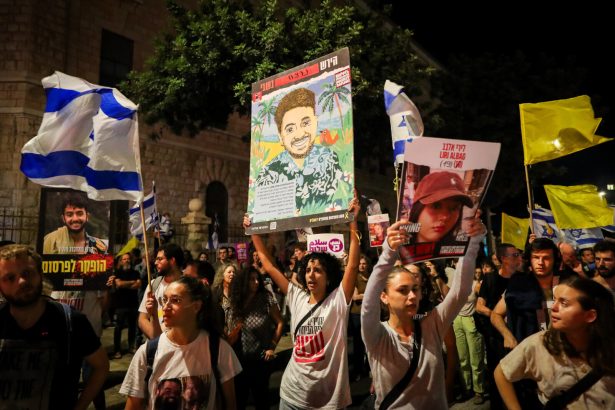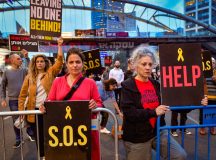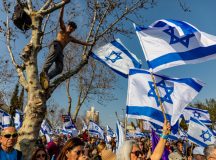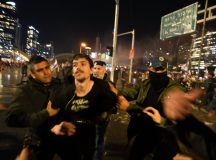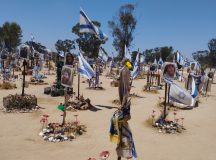Deputy Editor of Fathom Calev Ben-Dor shares his anguished reflections from Jerusalem after six hostages were executed by Hamas and massive street protests demanded an end to the war. “There have been many days since October where the contours of the journey from grief to hope have lacked clarity and direction. But Monday, Day 332, was one of the worst.”
Back to March 2023?
It’s Monday September 2, Day 332, and this level of unbridled rage, anger and frustration in the air hasn’t been felt for months. The decibel level outside is reminiscent of the anti-judicial reform protests and the night in late-March 2023 when thousands spontaneously thronged the streets to protest the government.
Then (as now), those demonstrations peaked after a deep disagreement between PM Netanyahu and his Defence Minister, Yoav Gallant. Gallant had warned (presciently?) that societal division over judicial reform was eroding Israel’s deterrence and it should be paused or slowed down, after which Netanyahu fired him (he later recanted due to public pressure).
Then (as now), the Histadrut called a general strike.
Then (as now), many believe Netanyahu is playing the petty politics of self-interest.
The immediate catalyst for this weekend’s protests was Hamas’ brutal execution of six hostages in Rafah, whose bullet-ridden bodies were found by the IDF on Saturday night – Hersh Goldberg-Polin (23), Eden Yerushalmi (24), Ori Danino (25), Almog Sarusi (27), Alex Lobanov (33), and Carmel Gat (40).
Yet what added fuel to the fire was the increasing feeling that the government is not doing enough for a hostage deal and ceasefire.
On Thursday night 29 August, the security cabinet backed Netanyahu’s position to maintain an Israeli military presence in the Philadelphi Corridor along the Gaza-Egypt border as part of any potential agreement. Israel’s security officials were reportedly opposed to the condition, while Gallant warned that without a ceasefire Israel faced ‘imminent deterioration into a multi-front war.’ The meeting became heated and voices raised, with Gallant decrying bringing the decision to a vote. ‘We have to choose between Philadelphi and the hostages,’ he warned. ‘We can’t have both. If we vote, we might find out that either the hostages will die or we will have to backtrack to release them.’
The proximity of that meeting to the hostages’ execution was the final straw for many Israelis. While leaders voted to remain ‘firm’, Israeli citizens were killed.
Our bifurcated reality
On Monday night, on a side-street near my house, police officers were blocking a mass of protestors holding Israeli flags from gaining access to Gaza Street near the PM’s residence. One kippah-wearing protestor symbolically held up his hands. ‘Shoot me you Ben Gvir mafia’ he said mockingly. ‘Hostages are being executed and they don’t care’ shouted another. The young police men and women – who one assumes would have rather been somewhere else – were dispassionate on the barricade and the crowd soon turned left to reach the main demonstration from a different route as requested.
At the junction, 20 metres or so from the residence, it was primarily calm (before the protestors successfully passed one barricade and drew closer). A neighbour walked his large Alsatian down the middle of the street until the dog lay down nonchalantly, seemingly unimpressed by the nearby commotion. Although many restaurants were closed, Zygmund, the hip café on the corner, played a Shlomo Arzi classic as some people sipped coffee and ate dinner. A police cordon and large van blocked access to part of the road. A special police unit, Yasam, talked amongst themselves while some young border patrol soldiers checked their phones. Soon afterwards they were joined by horses, which subsequently set the Alsatian off in a fit of barks. A picture of Hersh was plastered on the nearby pizza store. About a hundred metres away was a raucous cacophony of noise – drums, whistles and chanting. ‘We won’t give up’, they shouted on repeat.
It was a bifurcated scene reflecting how many of us have been living – trying to maintain normalcy whilst holding (sometimes successfully, sometimes not) the trauma, sadness and anger of Israel’s current reality.
Amongst intermittent shouts of ‘disgrace’, were chants of ‘Chayim, Chayot (alive, alive) and not in aronot (coffins)’ and ‘Everyone! Now!’ In the early months of the war, the ‘Bring Them Home Now’ demonstrators were reticent about joining with the ‘anti-government’ protestors. But now the two movements have broadly merged. As the crowd drew closer to the horses and police special-forces, the noise intensified. To the drum-filled staccato tune of ‘Isr-a-el is not a dictatorship’, oft-used during judicial reform, people now chanted ‘Why are they still in Ga-za!?’
Sinwar: A wannabe 21st Century Saladin
The answer to that question often takes the form of a political Rorschach test: The Israeli opposition blames the government; some right-wingers bemoan not enough military pressure on Hamas; American (and Israeli) Trump supporters blame Biden’s weakness.
But for me, it’s impossible to engage in such a conversation without understanding the nature of Hamas leader Yahya Sinwar.
Sinwar is brutal, imprisoned for murdering suspected Palestinian collaborators, including one who was buried alive. He executed a Gazan barber due to a rumour the man possessed obscene material he sometimes quietly and privately showed his clients. While in prison, he organised the murder of a woman suspected of an extra-marital affair.
He is ideological and uncompromising, opposing the Shalit deal (that brought about his own release) because it didn’t include other heavyweight Hamas prisoners. His influence was considered so great that it threatened to torpedo a deal that Israel (under Netanyahu) and Hamas both wanted. The prison services ultimately put Sinwar in solitary confinement until the agreement was signed.
Sinwar doesn’t blink at countenancing huge numbers of casualties for the cause. The Wall Street Journal revealed a message in which he approvingly cited civilian losses in national liberation conflicts such as Algeria, explaining them as ‘necessary sacrifices.’ He considers death (at least of others) as glorious. When Haniyeh’s sons were killed during the war, Sinwar told him that it would ‘infuse life into the veins of this nation, prompting it to rise to its glory and honor.’
Experts believe Sinwar increasingly views himself as a modern day Saladin, the twelfth-century Muslim hero who defeated the Crusaders. In a novel he once wrote, Sinwar’s protagonist, Ahmad – generally considered to be the author’s alter-ego – wonders whether there is a ‘Saladin for this era?’
He also genuinely believes Israel’s strength is temporary. ‘One day our roles will be reversed’ he calmly told one interrogator in prison. ‘The world will turn upside down for you.’ On 7 October he partially succeeded. He turned our world upside down.
Listening to the chants, I sometimes feel the protestors have a particular Israeli DNA running through their veins. After all, Zionism was built on the idea of daring and vision. Mapai MK and Minister of Education Ben-Zion Dinur (1884-1973) wrote that ‘Zionism stressed the idea that if human beings really wanted to, they could accomplish great things’ adding that ‘this belief in the nation and renewed estimation of its will became one of the pillars of Zionist ideology.’ As Herzl said, ‘If you will it, it’s no dream.’
It’s as if, if we only will something enough, it’ll happen. It depends on us.
But in this situation, its not only about us. Our hostages are in Sinwar’s hands. A man of natural compromise he is not.
Discussing how to balance war aims is legitimate; but Netanyahu’s store of credit has run dry
There is also a germane discussion over the balance between destroying Hamas, returning the hostages, and ensuring Israel’s long-term security. Many now believe the Shalit deal to have been a grave error. Others, certainly on the political right and centre-right, see Israel’s 2005 disengagement from Gaza to have been an unmitigated disaster (as they warned at the time). Hamas control over the Philadelphi Corridor and Rafah Crossing since 2007 has undoubtedly allowed it to strengthen militarily. The Gevurah Forum for Families of Fallen Heroes, relatives of those who have paid the ultimate price, believe a ceasefire agreement before Hamas is completely destroyed represents a dangerous humiliation that will only incentivise terrorist groups to carry out further attacks. ‘In their death they commanded us victory,’ read the posters of soldiers who have fallen in battle since the war began. These are all important and legitimate points the ‘ceasefire now’ crowd ignore at their peril.
But Sinwar’s pretensions of grandeur and discussions over how best to ensure Israel’s security should not obscure the fact that Netanyahu has lost any semblance of public trust he somehow managed to maintain after the 7 October debacle.
As thousands demonstrated in Jerusalem, Tel Aviv, and other places around the country, Netanyahu presented a PowerPoint emphasising the importance of Israel maintaining control over the Philadelphi Corridor. With arrows and sacks of dollars going from south to north, he demonstrated how Hamas had armed and financed itself, but pointedly omitted the Qatari money in suitcases that he had facilitated entering Gaza to help stabilise the Strip (and Hamas’ rule there). The PM also took the opportunity to criticise the Disengagement Plan (whilst omitting the fact he voted for it). It’s a well-rehearsed ploy that always reminds me of a pithy quote by political journalist Amnon Abramovich: that Netanyahu supported disengagement ‘in the Government and in the Knesset but opposed it in corridors and the television studios.’
That doubling down on the importance of the Corridor begs the question as to why Netanyahu-led governments never sought to retake control during the various operations against Hamas over the past 15 years. As National Unity Party Chairman Benny Gantz said, ‘It is amazing for the man who was afraid to begin a maneuver in Gaza and who did not want a maneuver at all in the southern part [of Gaza] is now explaining to the whole country the importance of one corridor that he didn’t want to go into in the first place.’
Netanyahu’s specific analysis may have merit (although the security establishment prefers to prioritise a hostage deal). But almost no one believes him anymore.
The PM’s motivations have often been questioned – when I sat with former Justice Minister Dan Meridor last year, he explained how Netanyahu has psychologically merged the state’s interests with his own. But in the last few days – following the shouting match in the cabinet, the vote on Philadelphi despite the security establishment’s warnings, and the execution of the hostages – this distrust has reached fever pitch. ‘If you can’t trust that the government is acting in the national interest, everything is broken,’ said best-selling author Yossi Klein Halevi on the For Heaven’s Sake podcast.
The journey between hope and grief
And indeed many of us do feel broken, devastated by the murder of those hostages. Hersh had become a household name in Jerusalem. Pictures of his face dominate the neighbourhood – on the bus stop I wait at to take my children to school, on lampposts near our home, on eateries we frequent. His parents, John and Rachel, exude compassion and hope. They became internationally known whilst maintaining a deep humility. Their story created sympathy and solidarity. In the increasingly polarised discussion over Israeli and Palestinian suffering, they were empathetic regarding the suffering of all.
In her eulogy yesterday, Hersh’s mother, Rachel, admitted the family had been ‘absolutely certain’ he would return home alive. Strange as it may sound, many of us believed that too. No matter how unlikely it seemed, there was something about Hersh and his parents that made us feel the story would have a happy ending. We imagined him being greeted like a hero by Hapoel Jerusalem football fans. We envisioned passing his picture and – amid the larger national tragedy of 7 October, the pain of which is irreparable – smiling over the triumphant return of at least one of Israel’s sons. He was first and foremost his own person and their son, but he also became a symbol. Like the nation, he was no longer whole – his arm had been amputated. But his return would constitute a small tikun, a restoration, for all of us, amongst the unbearable suffering of so many.
And then, having survived almost 330 days in captivity, he was brutally executed.
Rachel talked about needing to ‘transform our hope into grief and a new unknown brand of pain.’ But for those of us who didn’t personally know the family, our journey needs to go in reverse – to transform our grief into renewed hope.
There have been many days since October where the contours of that journey have lacked clarity and direction. But Monday was one of the worst.

